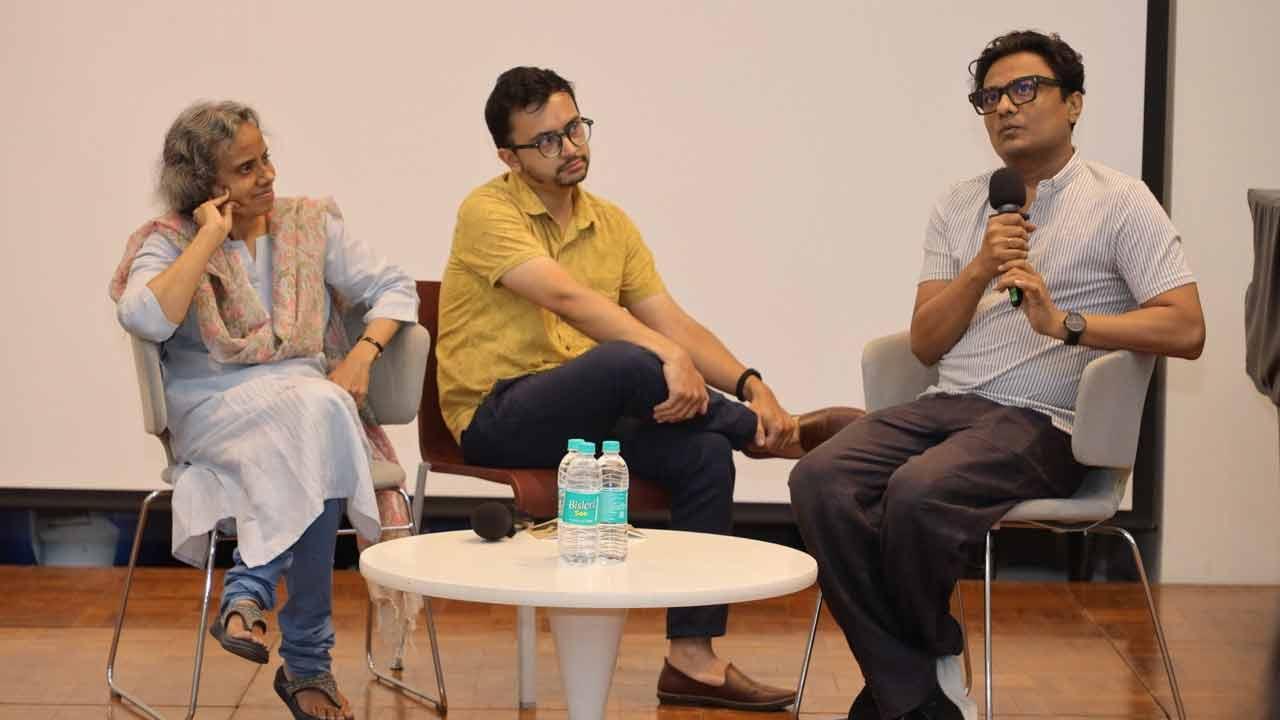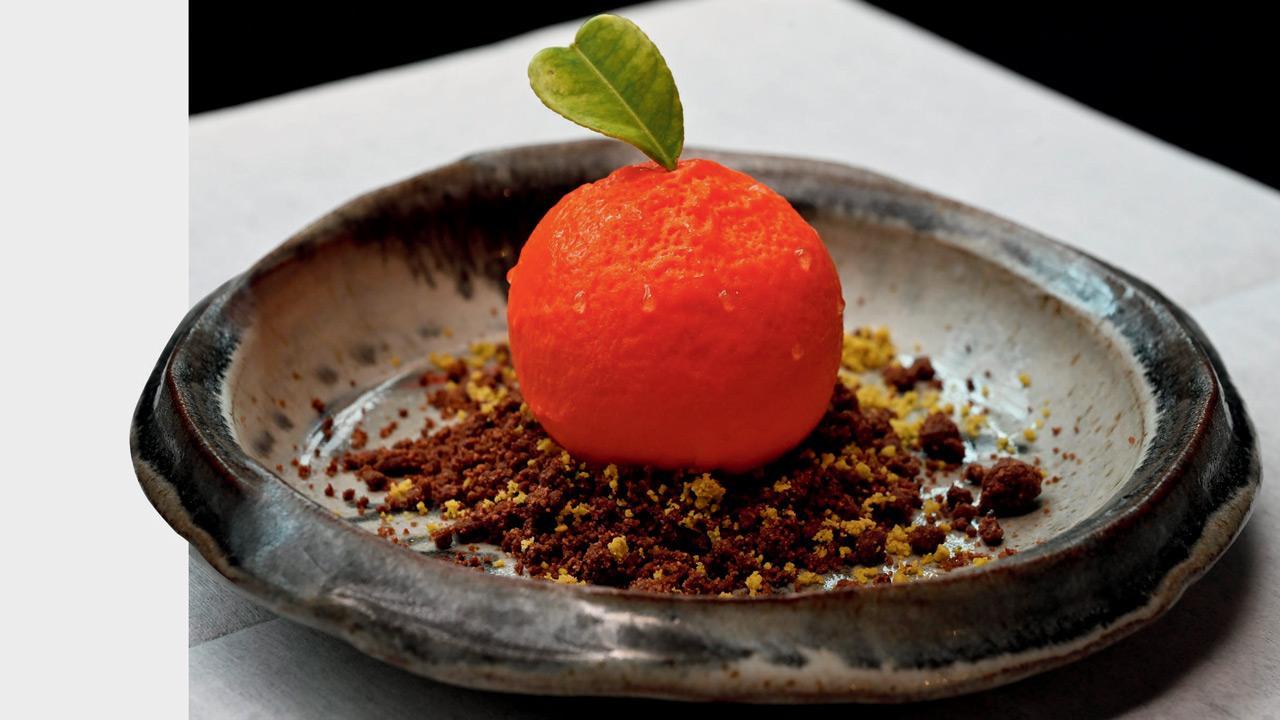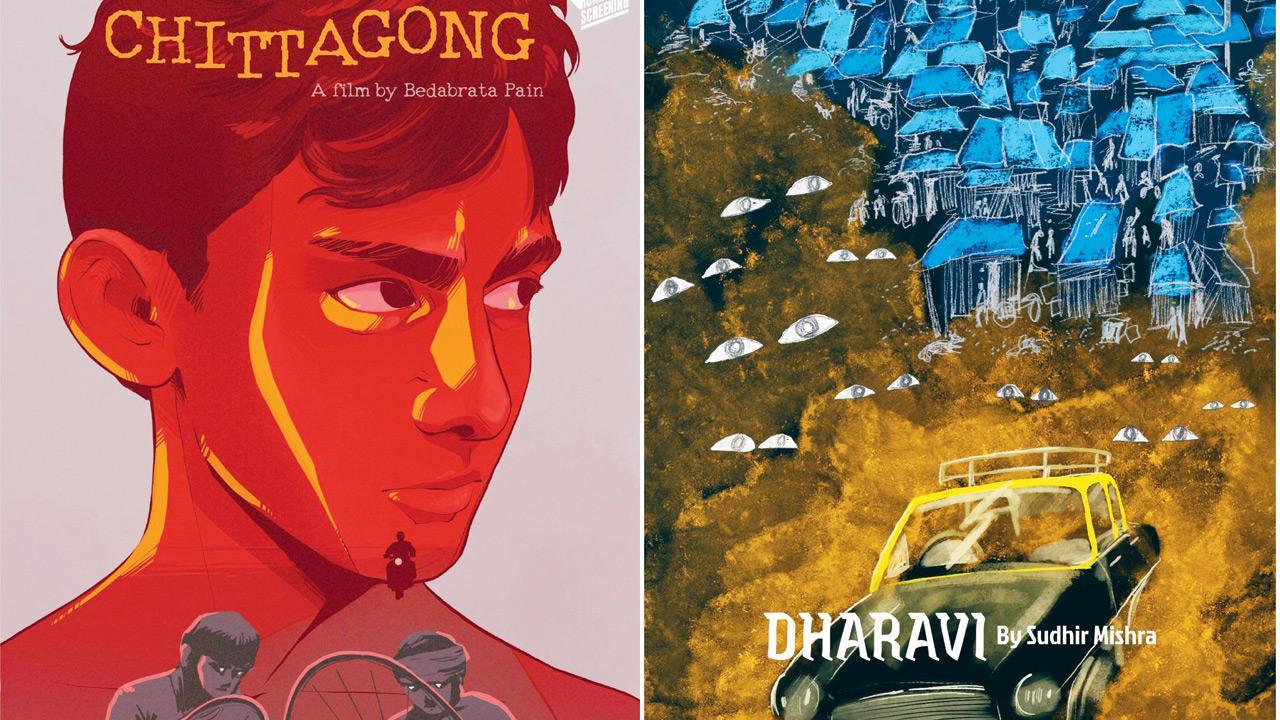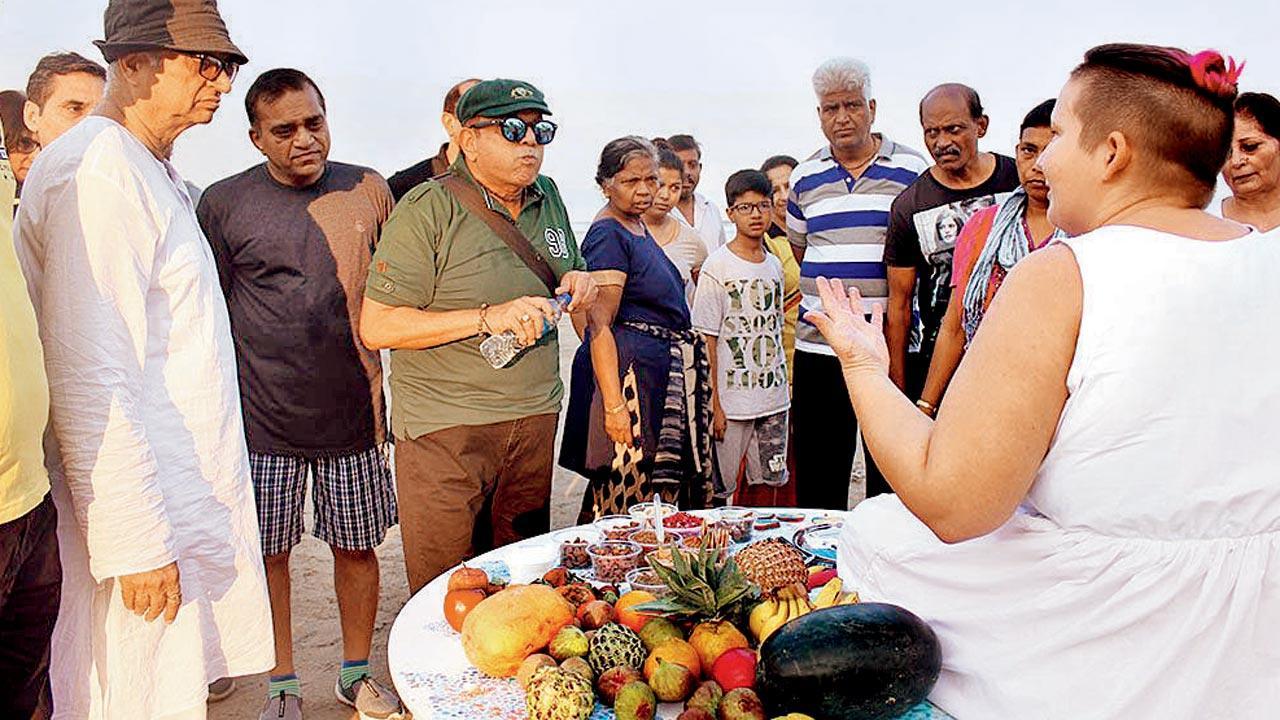Read Things To Do News
Celebrate World Earth Day 2025 with these events in Mumbai
Snaps from the wild From butterflies and indigenous flowering trees to birds, reptiles and marine biodiversity, attend the Indian wildlife biodiversity photography exhibition to witness a series of 150 photographs from wildlife photographers across the country.ON April 22; 10 am onwards AT Maharashtra Nature Park, Sion Bandra Link Road, Dharavi. Spot nature’s wonders Children work with seeds and twigs on a treasure hunt. Pics courtesy/Seeds of Banyan Embark on a unique trail organised by Seeds of Banyan to discover the gifts of our forest in this treasure hunt. Right from dispersed cotton buds, flowers, to seeds and unique leaves — gather your findings from the hunt to make eco-friendly art pieces with the children from Aarey Forest’s many local communities.ON April 22; 9 am to 12 noon AT Seeds of Banyan office, Aarey Forest.CALL 8928909437COST Pay what you can Clean up the shores Participants at a previous beach clean-up drive. Pic courtesy/Project Mumbai Roll up your sleeves and get to work with Jallosh Clean Coasts, a beach clean-up initiative that aims to collect and clean trash, plastic and other non-biodegradable materials from the city’s shores to preserve marine biodiversity and promote waste management.FROM April 26; 7.30 am to 9.30 amAT Multiple locations (Bandra Chimbai Village, Juhu Koliwada) REGISTER projectmumbai.org Katie Bagli Small steps can make a big difference >> Taps should be used judiciously. Do not open taps to their full capacity and let water flow like a torrent. >> Try to be innovative in your approach to deal with waste. Children can take the help of adults to craft toys out of waste materials. Bamboo toothbrushes. Representation pics/istock >> If you spot someone littering, speak up and make your opinion count. Convey your objection politely but firmly. >> Celebrate special occasions like birthdays in an eco-friendly manner. Try to make decorations out of waste and avoid balloons. Snacks could be healthy foods. Instead of packed juices, try natural drinks like hibiscus sherbet. >> Donate unused items like toys, outgrown clothes to institutions for the underprivileged. >> Collect the seeds of fruits you eat like mango, custard apple, chikoo and plant them wherever you can. They will grow into trees if well nurtured. Avoid using plastic straws >> Children can use the leftover water in their bottles to water wayside plants. >> Take only as much food in your meals as you can consume. Do not waste food. >> Make sure you do not accept plastic straws for drinks. Swap plastic toothbrushes with bamboo ones, if you can. >> Children can make posters in residential areas about eco-friendly practices like waste segregation. Information courtesy: Katie Bagli, nature writer and education director, Jane Goodall Institute India
22 April,2025 09:20 AM IST | Mumbai | Divyasha PandaSummer 2025: Explore these fun outdoor activities for kids in Mumbai
Nearly 45 percent of Mumbai’s children are overweight; 67 percent of them get less than an hour of outdoor playtime. If the quiet reminders before this didn’t work, perhaps these numbers should be a rude awakening for the city’s young parents. The Early Childhood Association (ECA-APER), in collaboration with the Podar Institute of Education, revealed these concerning statistics in a survey last week. “Kids prefer air-conditioned rooms to outdoor parks… They don’t like to sweat it anymore,” an expert had told mid-day in an April 17 newsarticle. Here are six outdoor activities that will have your kids running, jumping, laughing and yes, sweating. Land it right A trainer instructs a child at a gymnastics session. PIC COURTESY/GOFIGUREFITNESSindia on INSTAGRAM Your lazy post-afternoon-nap stretch has the potential to be so much more. Stretch, twist and tumble at Go Figure Fitness’s gymnastics programme for children. The collective has an exhaustive programme for children from as young as two years old. The classes are categorised into age groups, each focusing on a different set of real-life benefits. For instance, did you know an early introduction to gymnastics can help children develop stronger motor skills and co-ordination? Landing a perfect 10 doesn’t have to be the only goal. AGE GROUP 3 years and above ON Wednesdays and Fridays; 5 pm and 6 pm (below six years); 7 pm (above six years)AT Go Figure Fitness India, Kolivery Village, Vidya Nagari, Kalina, Santacruz East.LOG ON TO @gofigurefitnessindia 3 years and above Skate to the party Skaters at Somaiya Sports Academy, Sion. PIC/ASHISH RAJE Lace your roller skates up and feel the wind in your hair at guided sessions across the handful of skating tracks in Mumbai. A three pronged programme at The Skate Academy accommodates beginners and intermediates as well as professional aspirants. Beginners get to choose from speed, freestyle or artistic skating based on personal preferences. Guided by coach and veteran roller skater Ajay Shivlani, the academy promises to keep injury-minimisation at the core of its training system. AT Somaiya Sports Academy, Sion; other venues in Bandra and Ghatkopar.LOG ON TO theskateacademy.in 3 years and above Make a splash A toddlers’ swimming session in Sanpada. PIC OURTESY/MICHAELPHEPLSSWIMMING ON INSTAGRAM This quintessential summer activity isn’t going out of style any time soon. Learn swimming from certified trainers of the Michael Phelps Swimming Academy across the city. The Get Wet programme at the academy is designed for parents of toddlers as young as three years old to help their child step out of their comfort zone in the water with games. From breathing techniques to acing strokes, a step-by-step programme encompasses the fundamentals of swimming under the watch of trained lifeguards. AT Multiple locations across Andheri, Kurla, Vashi, Chembur, Sanpada, and other suburbs.LOG ON TO michaelphelpsswimming.in 3 years and above Surf excellence A surfer rides a wave in Virar. PIC COURTESY/MUMBAI SURF CLUB Surfing isn’t just for distant shores. The Mumbai Surf Club’s surfing sessions are open to participants over eight years old. While the waves are relatively high during this time of the year, expect the age bar to drop to six years in the latter half. The club is Surfing Federation of India-certified with a roster of instructors certified by the International Surfing Association (which also entails mandatory lifeguard training). Each 90-minute session begins with a briefing on the shores before hitting the waves. While riding a wave might seem exciting, be prepared to sweat it out before you sign up. ON Tuesdays closed; timings announced on a day-to-day basis AT Mumbai Surf Club, Rajodi Beach, Virar.LOG ON TO @mumbaisurfclub 8 years and above Escape the box A kickboxing session in Breach Candy. PIC COURTESY/JUNIORFIT Kick it back, literally, at this kickboxing training programme by Junior Fit, a fitness platform based in South Mumbai. The ongoing sessions in Breach Candy offers children who wish to improve stamina, build confidence, and sharpen focus a specialised one-on-one experience. For children who prefer battling the sun in familiar terrain, the platform also offers simpler at-home services for toddlers and teens. Choose from obstacle courses, aerobics sessions and yoga classes. AT Gold’s Gym, Shyam Nivas, Bhulabhai Desai Marg, Breach Candy. (At-home services available city-wide)LOG ON TO @juniorfitindia 10 years and above Out of the park A child learns a vault at a session. PIC/ATUL KAMBLE Learn how to hop, skip and jump through imaginative obstacles at the Mumbai Movement Academy’s arenas. From making giant leaps to striking the balancing act just right, children start from the basics under supervised environments. With trial courses available for those who want to test the waters before making the dive, the academy also has a children-focused summer camp around the corner. The daring stunts are overseen by Art du Deplacement and Parkour Teaching (ADAPT)-certified trainers. Given the distant deadlines for Mumbai’s roadworks, we’d call this a long-term investment. ON May 5 to 16 (summer camp)AT HVB Global Academy, Marine Drive. Other sessions in Andheri, Juhu, Bandra, Kemps Corner, Powai. LOG ON TO @mumbaimovementacademy 6-14 years
22 April,2025 09:16 AM IST | Mumbai | Devashish KambleThis two-day film festival in Mumbai aims to narrate stories from South Asia
Films as an art of storytelling have a great impact on our lives. The Asia Society of India Centre is organising a two-day film festival titled Parda Faash at NCPA’s Little Theatre. The event’s theme is The Poetry of Presence. The festival aims to narrate non-fiction stories from and about South Asia which includes India, Pakistan, Bangladesh, Nepal and Sri Lanka. Inakshi Sobti, CEO, Asia Society India Centre, explains the theme of the festival, “We wanted to talk about everyday, individual lives, and how the profound lurks in the mundane.” She added, “The festival is called Parda Faash because we wanted to pull back the curtain on life in South Asia by bringing together films about the realities of life in the subcontinent, which are best expressed through the perspective of the individual. What does climate change mean for the individual walking along a vanishing mangrove? Who are the people that make up a massive public uprising? We wanted to see what happens when we observe life on the periphery of society with an open mind, and engage people in conversation through film.” Film Screening of Amid the Villus at Parda Faash 2024 The Centre aims to highlight issues in South Asia and have dialogues around it. She elaborated, “Through film, we come to see that experiences of grief, hope, and determination are not bound to India. Films can reach people in a way that is unlike anything else; people can slowly slide into the skin of a farmer, a young trans person, a classical musician and wonder how many unique, individual lives exist within the same boundaries on a map.” To have an effective conversation around independent films, they will also have panel discussions. One of the key panel discussions is on the future of independent cinema. Sobti talks about the highlight of the event, “Our closing panel is with Anand Patwardhan and the directors of Chardi Kala on the future of independent cinema; we’re hopeful that people will be provoked to slow down, feel, and respond to the conversations.” Inakshi Sobti Bruce Guthrie, Head of Theatre & Film, NCPA, said “This festival stands as a vital platform for independent, non-fiction filmmakers from across South Asia — artistes who are capturing the complexities of our time with nuance, sensitivity, and courage.” When asked about her opinion on the power of cinema, Sobti explained, “There’s a power that comes from deliberately cultivating a nuanced understanding of the world, particularly in an age of constant information bombardment. Independent cinema is a path for understanding the lives of others in our shared society, and we hope people will enjoy the films, the discussions around them, and revel in being curious around curious people.” AT April 26-27, Little Theatre, NCPA, Nariman PointTIME 10.30 am - 6.30 pmENTRY FREE
22 April,2025 09:12 AM IST | Mumbai | Minal SanchetiThe Tokyo twist: This Bandra restaurant serves a fresh take on Japanese flavours
A chance meeting, a shared dream, and a casual collaboration, jamming around food ideas, brought together Bandra boys — chef Anand Morwani (The Big Zest, Rocketman Pizza, ex-Brewbot); Rohan Mangalorkar (The Big Zest, Rocketman Pizza, Pack-a-Pav) and Karan Gaba (Bokka Coffee, Farmers Cafe, Bombay Salad Co, and Tamari) — to create Gaijin on Linking Road. Gaijin, meaning outsider in Japanese, brings a fresh take to the table. “Hailing from a QSR background, launching a full-scale restaurant was a leap, but it felt like a risk worth taking,” says Mangalorkar. During a space scouting mission, he and Morwani bumped into Gaba at his restaurant. “We’d known each other, but that day, something clicked. We were all eyeing the same spot,” recalls Morwani. Gaba adds, “We wanted something different — fresh, grounded, and full of soul. The space chose us, not the other way around.” The concept took shape after Morwani’s month-long visit to Japan. He returned with a vision: Japanese flavours through French and Italian techniques. There are no rules, just rhythm. Tenderloin katsu vs yaki We began with mule-tea (Rs 475), a botanical concoction of liquorice, hibiscus, and earthy warmth. The space balances brutalist edges with playful sophistication. Downstairs, it’s lively, featuring a seven-tonne Suiseki stone waterfall, a bar, an omakase counter, and a vinyl-driven music vibe. The upper level is intimate — 18 seats, dimly-lit and private. Out in the back is where a Tokyo alley collides with Mumbai’s mischief — neon buzz, graffiti shutters, and eclectic signboards. Crab udon noodles The beverage menu is playful, from a gaijin’s perspective, brought to life with cocktail-inspired textured illustrations. For Mangalorkar, Morwani, and beverage manager Nischal Suman, a three-day trip to Bangkok involved sipping 180 cocktails and endless exchanges with bartenders, pushing the boundaries of ideas, techniques, and flavours along with beverage consultant Varun Sudhakar. We liked Mt Fuji (Rs 1,250) — crisp, floral, and clear, revealed dramatically in ice with two pours per cocktail. Midsummer ritual (Rs 1,050) blends guava pisco, green grape, melon liqueur, clarified milk, matcha, and sancha tea into a fruity, earthy, velvety sip. Banoffee We started with tuna akami vs. chutoro temaki (Rs 990) — a nori taco with avocado, tuna akami, and chutoro topped with wasabi foam. But our standout was the not buff carpaccio (Rs 690), a playful take on the classic combining buff carpaccio, tartar, roasted bone marrow, pickled celery, ginger-scallion slaw, and crunchy togarashi spring roll shells, finished with a parmesan-shiso balsamic glaze. The chicken gyoza (Rs 510) takes cues from Osaka’s Dotonbori street food, reimagined with edamame-jalapeño purée, soy milk beurre blanc with dashi, and a hint of rayu (Japanese chilli oil). It is topped with crispy chicken skin, more edamame, and umami-rich beurre blanc — familiar yet new. The morel mushroom (Rs 850) pairs Himalayan morels with smoked miso-enoki, duck tartare, and a white miso-takuan glaze, and is finished with fresh truffle or house-aged sushi soy for added umami. Midsummer ritual The salmon aburi with bone marrow glaze (Rs 690) features belly-cut salmon smoked tableside and glazed with slow-cooked bone marrow, offering rich layers of flavour. The tenderloin katsu vs yaki (Rs 690) recalls Dotonbori street food: tenderloin kushiyaki paired with a smoked oxtail croquette, topped with foie gras glaze and a sharp gastrique, over sweet corn purée — a nostalgic plate from Morwani. The lamb ribs (Rs 1,190) were another favourite — glazed in toban yaki and finished with crispy ginger, spicy goma, sesame seeds, and scallion curls — rich and bold, perfect for sharing. Served tableside, the crab udon noodles (Rs 1,450) had our heart. It uses every part of the crab for a bisque-style sauce. Noodles are cooked in crab stock, absorbing briny sweetness, finished with saikyo miso, fermented usu posho butter, crab foam, and chilli oil. It’s rare to see chefs give desserts the attention they deserve — many are outsourced and simply plated. But here, chef Morwani takes a hands-on approach, beginning with the brie cheesecake (Rs 790), a playful twist on a cheese board with wasabi crackers, meant to be broken, smeared, and drizzled with pink peppercorn honey. A stroll through a Kyoto garden inspires the mandarin (R740). This dessert, shaped like a fallen mandarin, features a white chocolate and cream cheese mousse laced with Cointreau, resting on a chocolate-pistachio streusel. Edible gel dewdrops, mimicking morning moisture, complete the experience. The banoffee (Rs 690) is a layered masterpiece: lime panna cotta, chocolate brownie, and roasted brûlé-ed banana topped with pecan praline and chocolate-orange ice cream. It is finished with a miso-infused coffee namesake and a shard of caramelised miso white chocolate for an unexpected umami crunch. GaijinAt Lotia Palace, Linking Road, opposite Citi Bank, Khar West.Time 12 noon to 3 pm (lunch); 7 pm to 1.30 am (dinner); Mondays closedCall 8591615552
22 April,2025 09:06 AM IST | Mumbai | Nasrin Modak SiddiqiExpert tips to style the trending East-West handbag this summer
Reinforcing, once again, the often-repeated adage that fashion is invariably circular and what you thought was ‘dated’ and ‘out of style’ can come back as the ‘it’ trend of the season with a gentle rebrand — the bag that everyone’s coveting this season is the long and narrow East-West bag. Eerily reminiscent of the tiny baguettes that were a 1990s wardrobe staple, these long, thin bags are everywhere, and are being hailed for their day-to-night versatility and sleek, elegant aesthetic. Kendall Jenner’s East-West bag is casual chic. PIC COURTESY/KENDALL JENNER ON INSTAGRAM (right) Personalise your bag with keychains. PIC COURTESY/ELLEN TERRENCE ON INSTAGRAM “What makes these bags so popular is that they are large enough to be functional while still being sleek enough to pair with relatively dressy looks,” says celebrity stylist Mitali Ambekar. She adds that the elongated shape pairs well with both tailored and flowy silhouettes, which takes a lot of the decision-making out of the getting dressed process when you’re rushed for time. Dress it up, or down The bags pair well with flowy silhouettes. PIC COURTESY/PINTEREST (right) Hailey Bieber demonstrates high-low dressing. PIC COURTESY/Hailey Bieber ON INSTAGRAM While the classic East-West bag has a very structured handle that typically sits at the centre of the bag, you could just as easily pick a similar silhouette in a slouchy or crossbody style for your regular or casual fits. “For work, aim for a more minimalist look with a structured leather piece in classic tones. Wear this with high-waisted trousers and loafers to look instantly put-together. For evening wear or a more maximalist look, opt for a metallic purse or one in jewel tones,” shares Ambekar. The bag’s elegant silhouette lends versatility. PIC COURTESY/beautyluxelover ON INSTAGRAM The crossbody style wears well if you pick a piece in soft leather, and wear it with an oversized hoodie, shorts or denim jorts, and chunky sneakers. The style also adds to the delicate appeal of midi-dresses, or satin slip dresses and skirts. Khushi Kapoor sports an East West bag (right) Pair your bag with oversized shirts. PIC COURTESY/KHUSHIKAPOOR INSTAGRAM; PINTEREST All about proportions The relatively small dimensions of the bag can make it disappear under extremely bulky or voluminous outfits. Because of where the bag sits on your body, it’s also advisable to not add too much fabric around your waist. Simpler silhouettes that are either tailored or flowy can match the bag’s less-is-more vibe, says Ambekar. Mitali Ambekar To get the most wear from your bag, personalise it with a silk scarf or keychains. Depending on the time of day, or the rest of your outfit, you could carry the bag by the handles or sling it across your torso like a crossbody, she signs off.
21 April,2025 08:51 AM IST | Mumbai | Anindita PaulMumbai: This Versova-based initiative is Indie cinema's happy home
When Killa (2014) director Avinash Arun watched his debut feature film at the first screening of Versova Homage Screenings (VHS), a decade after the release of the film, he was met with a roaring applause and left the hall teary-eyed. He had just experienced something deeply emotional that comes with returning to the first project and reliving everything that went into making it. As the audience snaked out, he took a few minutes before following them for an interactive one-on-one session about the making of his film. “This intimacy is what VHS is about,” says Rohan K Mehta, founder of the initiative that recently completed a year of screening indie productions and cine classics. An artist presents Payal Kapadia and her team with a reimagined poster of A Night of Knowing Nothing (2021). PICS COURTESY/Mohit Manwani A VHS event is built on the idea of developing a community around filmmaking that learns from each other. Mehta believes that the city, despite being so central a location for filmmakers and creative artists contributing to cinema, lacks a space where emerging artistes can freely approach professionals. He recalls working as an assistant director and production designer, “When you work on sets for others, you don’t always understand how to get finances, get the crew on board, and get the cast aligned,” he tells us. “When you’re assisting others, they are the ones who are arranging for these things, and you aren’t privy to such aspects. So, when I had a script ready, I didn’t know how to make my film. I didn’t have a community to learn from.” Hansal Mehta at a film screening organised by the club Mehta went in search of this community in 2023 to the Goa-based Screenwriters’ Lab, an annual project under NFDC’s Film Bazaar, which offers young screenwriters mentorship. “At the lab, I found mentors who honed my script and taught me about these aspects. Everybody was a film professional there and one could talk to anyone.” What he couldn’t learn over the years, Mehta reveals, he learnt in a matter of a few days. The impact of the mentorship programme nudged Mehta to bring something similar to the city, which would encourage free-flowing conversations and connections between professionals and emerging artistes in the field all year round. “Since the industry is so unorganised, some kind of organisation makes a difference.” Mehta and his brother Prayrak Mehta, with their team, have screened 20 different films over the last year, including cult classics like Satya (1998), Udaan (2010), Ship of Theseus (2012), and independent films and debuts of well-known filmmakers like Payal Kapadia and Hansal Mehta. The Q&A section is the most exciting aspect because an established filmmaker moderates the session with the filmmaker in focus. In this scenario, emerging artistes get to actually understand what went into the making of the film from the masters and the snags to avoid. Rohan Mehta The team doesn’t compromise on the quality. This is why they prefer screening in cinema halls. Mehta explains, “Since we talk about the technicalities of the film, we should get to observe them and watch how the film is intended. We started with a preview theatre, a 50-seater hall. We called everyone we knew for the first screening.” By the fourth screening, the numbers spiked to thousands that were registering for the screenings to watch the magic of these films come alive on the big screen again. The team had to begin a curation process, since the seating for such screenings is limited. They now screen all the registrations, and the IMDb profiles help them gauge the work of those registering. Though tedious, the process has helped them ensure that those who are genuinely interested in educating themselves about the medium and will contribute to the community are not left out. “You have to maintain the sanctity of the place you’re screening at, so we can’t exceed the capacity of the place. But each time we try to curate new people, so we can get as many creatives [to benefit from this] as possible.” The project is currently running on the team’s personal financial sources; they hope to keep it sustainable by reaching out to more people. “It’s a high technology initiative. It’s expensive to screen in, say, a PVR because there are a ton of processes, like government regulations to start with.” In addition to this, there are internal costs and costs of booking theatres. What they’ve been most fortunate with and grateful for is the response from the filmmakers, who have been warm and welcoming of having their films screened. Every artist looks for an opportunity such as this to get a space where they can display their work, Mehta concludes. “As a filmmaker I want to show my film to people who really want to watch it. Art is nothing if it doesn’t have its patrons.” Upcoming screeningOn April 22; 5.30 pm onwardsFilm Salim Langde Pe Mat Ro (1989), dir. Saeed Akhtar MirzaE-mail contact@versovahomage.com (for registration and venue details)
21 April,2025 08:45 AM IST | Mumbai | Nandini VarmaI have always been fascinated by monikers, stories, enigmas: Nischay Parekh
Someone just hit a car outside, didn’t they? That’s alright. It is a part of Mumbai,” comes the quick quip across the phone as this writer tries to take notes amidst chaos. Trust a musician to spot a disturbance in sonic frequencies during a conversation. Nischay Parekh exudes geniality and humour that was part of his last venture, Parekh & Singh. Now, he is set on a new project, just as quirkily named, TV Dinner, that will come out with a third song, Feel Alright, this week. “I have always been fascinated by monikers, stories and enigmas,” shares Parekh, who admits to being a binge-watcher of everything on television. The project will release their third song since February, on April 25. “It is a song about my longstanding relationship with anxiety and the creative process,” he admits. Moving on This element of personal experience, easy harmonies and melodies carry resonance of his collaboration with Jivraj Singh. The news of the duo breaking up was out in February, causing some disappointment among fans. But the duo was prepared. “We knew that Lollapalooza 2024 was to be our last live performance before a long hiatus. I knew that because I was a new father, and wanted to experience that. Plus, we had created all we could. Jivraj has been performing for over 16 years, as have I, and we wanted to do something different,” he shares. Nischay Parekh (centre) in performance from an event last week in Dubai. PICS COURTESY/NISCHAY PAREKH Easier said than done. With parenting also taking up his time, it was never going to be easy. “It [parenting] is quite challenging, and very educational,” he laughs. It was his habit of constantly jotting down notes over a decade that helped. The notes gave birth to the first single, Guessing game — a song about his journey as a new father and an artiste finding a balance. The songs are melodic, personal and carry a pared down simplicity that adds to its texture. “The process was very organic. I teamed up with Rohan Rajadhyaksha [co-producer], and had known Nikhil Vasudeva [drummer] on the music circuit. Rohan, in turn, knew Rhys [Sebastian D’souza], and slowly, we began to bring in artistes,” he reveals. Over five days in Khar’s Island Studios in June 2024, the project recorded eight songs. With no set plans, the artistes too, improvised. Rhys, Parekh reveals, brought in a clarinet instead of his signature saxophone. A moment from the new video, Non Believer, from TV Dinner There was uncertainty, but a sense of discovery too. “The big difference from it [Parekh & Singh] was that my ‘audiation’ — the process of having a sonic idea of the concept — was open-ended. As each day passed, it was like a sculpture where the shape slowly emerges.” With the second track, Non believers, releasing in March, it feels like the composer is on a speed run. “My approach is to be a little more prolific. I want to release a song every month,” he admits. It might be an interesting watch ahead. RELEASE DATE April 25LOG ON TO Nischay Parekh on YouTube, Spotify, iTunes.
21 April,2025 08:40 AM IST | Mumbai | Shriram IyengarThis photo book features dogs who survived on Goa's beaches during the lockdown
In my hour-long chat with Mr Ratan Tata, 45 minutes were about dogs, and the rest of the time, we discussed the world. It was ironic for me to meet his favourite dog, who is called Goa,” Rohit Chawla recalls via a phonecall, his time with the late business icon and supporter of animal welfare, in between a busy schedule in Hyderabad. His recently released photo book — Rain Dogs (HarperCollins) — is the centre of our discussion, as he recalls piecing his labour of love during the lockdown. “It began as an obsession to capture stray dogs. I ended up with 10,000-odd photos from across the world! I adopted three strays after I made Goa my home; Marco, Polo and Hero were abandoned during the lockdown.” To put an end to his obsession, his wife, Saloni suggested he plan an exhibition to showcase these prints. The ongoing photo exhibition that opened on January 1 at the Aguad Port and Jail Complex, will travel to other Indian cities, including Mumbai. “I’m partial about having it in the monsoon here; the book is titled Rain Dogs, after all,” he adds. Sure, the dogs are the showstoppers but the copy — lyrical, prosaic, and sometimes, stark — organically and evocatively weaves its way across the slickly-designed book. Chawla was working on a project for the past 20 years to photograph 300 of the world’s greatest authors for a book that is set to be released at the 2027 edition of the Jaipur Literature Festival. “I know them well; many are friends who have an affinity for dogs. I was cognisant of the fact that the book should have different styles, and not get intimidating. A book about dogs has to be intimate,” he states. “Vikram Seth, who is usually evasive, responded in 15 seconds after I sent him a photograph of a dog.” All the proceeds from the exhibition and the book will be donated to animal charities. Edited extracts from the interview: MID-DAY: Take us back to the moment when you spotted the first dog on a beach in Goa that made it to this book? What convinced you to photograph it?ROHIT CHAWLA: I started this project in June-July 2020. The cover picture (right) of the migrant and his pet dog was a definite impetus for this series. In those bleak days of the pandemic, I used to see him on most mornings at a particular spot on the dream beach end at Vagator beach staring longingly at a distant horizon of sorts. And though I had photographed him on several occasions but that one particular day, all the elements came in unison: the fishing boat, the bird, and the dog, all conspired together to create an image of longing and desire during the pandemic.The title of the book was suggested by Jeet Thayil, and that somehow dictated a certain colour palette and the poetic nature of the images that followed my own visual trajectory. The quiet minimalism of the seascapes and these forgotten dogs became my essential metaphor during the pandemic. MD: The lockdown was obviously tough on strays. What survival lessons did you observe? Did they become life lessons for you as well?RC: Since the beaches were no longer a happy hunting ground of leftovers for the dogs, the first few weeks were extremely tough for the dogs. But soon, a whole bunch of volunteers got together and did their bit and many Westerners, who were stranded in India, were particularly kind to these dogs. But it was not so much the food. Eventually, the dogs missed human company in equal measure. It was painful to lock eyes with some of them, because they would follow you for miles on the beaches. I had to learn to avert my gaze at times because I didn’t want them to be displaced from their intrinsic self-defined territories on the beaches. Since I had chosen to live on the beach myself, we sustained each other emotionally too. MD: What role did the rain play in composing these photographs? RC: Goa is at its magnificent best in the monsoon, and the rain helps create a unifying de-saturated colour palette that does away with the harshness of light by adding that elusive atmosphere which feels particularly surreal and magical even to a somewhat jaded photographer’s eyes. Watching an overcast deep grey monsoon sky, a raging sea enveloped by relentless rain was the perfect aria for an opera fiend like me. MD: What are some of the most unforgettable moments that you will cherish from this project?RC: There were some magic moments. A favourite (above, left) focuses on a fisherman in black, fishing, with his black dog in attendance, like a proverbial lead violinist of sorts as he conducts the perfect monsoon symphony in a panoramic and surreal seascape in shades of green. This was at Morjim, near Turtle beach. Another favourite also with a fisherman in yellow that translated a beautiful feeling when the frame was made. I had also spotted a dog (below, extreme left) hidden among the rocks. They often retreat into their own space. AVAILABLE Leading bookstores and e-stores COST Rs 1,999
19 April,2025 09:01 AM IST | Mumbai | Fiona FernandezAttend this session in Mumbai to explore the power of disruptive storytelling
How many times have you felt restricted in doing things you desire because they don’t fit a certain social criteria? In a world where conventions tend to overpower identity and individuality, where social disparities are getting stronger each day — arts are possibly one of the only channels through which one can challenge the strictures, disrupt the 'norm' and engage in a conversation that fosters growth. Exploring a similar line of thought in Writing a riot, a talk hosted by city-based organisation Freestyle, in collaboration with Bhasha Centre and Harkat Studios, Botswana-based writer, interdisciplinary producer and researcher, Kat Kai Kol-Kes will join Freestyle founder, Sameera Iyengar, in a conversation that will explore disruptive storytelling and writing. The session will further strengthen its ideas through a rehearsed reading of two plays, Gnash and Talking Heads, written by Kol-Kes. Sameera Iyengar and Kat Kai Kol-Kes “Art can help us understand the world through different portals. It is one of the most powerful ways through which you can bring socio-political conversations to the fore and look at issues from multiple standpoints. She [Kat] is a wonderful multi-genre artist with a very strong understanding of writing. It was the perfect opportunity for us to host her considering the theatre community in the city is also quite strong. Fellow artistes and performers, Oysh and Diya Naidu reached out to me to conduct the session,” Iyengar explains as she tells us about the play readings being helmed by Mumbai-based directors, Rachel D’Souza and Amba-Suhasini K Jhala. While Talking Heads explores the stereotype of how black and brown women over the age of 40 or maternal caretakers are often thought of as individuals who don’t need to engage in pleasure or sensual pursuits, Gnash talks about the taboo of women being perceived as defenceless or at the receiving end of violence. “The play is open to interpretation to the cast as well as the audience. The idea is to use the stories as the basis to challenge notions of purity, chastity and normativity and embrace disruptive storytelling,” Kol-Kes shares. “With the engagement, I am trying to provide insights on the work that I have been doing as playwright, and provide greater visibility to the LGBTQiA+ community and people living on the margins,” she adds. In India for the East Goes South Residency, supported by the Miller-Zillmer Foundation, Kol-Kes has toured Kolkata and Bengaluru as part of her project before stepping into the Maximum City. Iyengar observes, “Nowadays, it is almost as if all of us are living in silos, which is why it is important to have conversations that help us expand the idea of ourselves. It is fortunate that we have an artist from Botswana share her knowledge with us. One also cannot undermine the shared experience of colonialism that India and Africa share despite having different historical trajectories. In that sense, art paves the way for difficult conversations and creates an inclusive environment.” ON April 19; 11 am to 1 pm AT Harkat Studios, JP Road, Machlimar, Versova, Andheri West. LOG ON TO altshows.comFREE
19 April,2025 08:48 AM IST | Mumbai | Divyasha PandaCatch this Serbian artiste's performance art workshop in Kanjurmarg
We’ve seen people toss a dart at the map to plan their next travel destination. But we suspect Serbian artiste Katarina Rasic chucked hers at a keyboard instead. From Belgrade to Brazil to Bangkok, Rasic has made quite the ‘B-line’ across the world with her performance art works. Next in line, she has made Bandra her home. This weekend, a community art space in Kanjurmarg will open its doors to Rasic’s immersive, community art workshop. The last time this writer spoke to an artiste from the Balkans, it was a rushed, almost incoherent chat with a rocker behind the scenes of a concert. Our conversation with Rasic, however, flows with unusual familiarity. “I first landed in India in 2012. I was looking for artist residencies and ended up in Bengaluru. India became my second home before I moved to South America,” she reveals. In her more than a decade-long break away from India, Rasic occasionally returned to showcase her performances. At one such experiment on Juhu Beach in 2017, Rasic turned heads by stepping out in a white dress with sliced fruits in hand. “I urged spectators and passers-by to grab a bite and allow the flavours to slowly take them back to an emotion or a time in their life. They then wrote down their memories on my dress, which then became a canvas,” she recalls. Performance art is a constant, collaborative effort, she says. “You really don’t have to be a trained artiste to join in. But every contribution adds profound meaning to the performance’s outcome. The more the merrier,” Rasic explains. At the art space in Kanjurmarg today, Rasic is laying out long white canvases. “We will be creating symmetrical shapes using both hands, incorporating movement in the performance,” she gives us a sneak peek. The Serbian artiste prepares for the session in Kanjurmarg. Pic Courtesy/Janhavi Ambavane; (right) Rasic performs Dream Box, a story of unrealised dreams in Belgrade in 2015 The workshop will stand in stark contrast to the artiste’s 2015 project in Belgrade, where she squeezed her way into a claustrophobia-inducing box in public view. The idea, she reveals, was to remind people of their dreams that died when they decided to work in boxed offices and cabins to earn a living. This city — the hallowed city of dreams — could use a reminder, we suggest. But the Serb assures us she’s barely claustrophobic, or even homesick, in her new abode in Mumbai. “The East European way of life is quite distinct from the more individualistic sensibilities of the west. When I step out in the community markets of Bandra for groceries, everyone seems to know each other. They’ll occasionally greet you and ask about your day. It does feel like home,” she admits. Rasic was born in the Socialist Federal Republic of Yugoslavia and saw it evolve to the Federal Republic of Yugoslavia, then Serbia and Montenegro, and finally, Serbia. “In that sense, the concept of home has always been an interesting subject for me. But for now, I’m calling Mumbai home, and am looking for collaborations with more spaces,” she reveals. “Although, I’m a bit overwhelmed at times. Serbia is a small country. Mumbai has more people than the entirety of my country, you know?” she laughs. Good for us, the more the merrier. ON Today, 10 am to 1 pm; upcoming sessions in May and JuneAT Jolly Art Adda, I Think Techno Campus, Nehru Nagar, Kanjurmarg East. LOG ON TO @jollyartadda on InstagramENTRY Revealed on request
19 April,2025 08:37 AM IST | Mumbai | Devashish KambleExplore India's diverse folk music culture through this performance in Mumbai
The Rasa Experience, a celebration of India’s indigenous folk music, is back in the city for the second edition of its multi-genre musical fest. The fest will bring to town some of India’s most revered folk musicians from Rajasthan, West Bengal, and Uttar Pradesh in performances that tap into India’s musical heritage. From sessions that include Bengal’s Baul music to ensemble performances by artistes like Ishaan Ghosh, Kabir Khan, and Manjoor Khan, you can also explore shopping from stalls that will host handcrafted goods created by artists from the country at the fest. On: April 19 and 20; 6 pm onwards At: The Kalangan (Amphitheatre) at Sangit Mahabharati, JVPD Scheme, Juhu Log on to: in.bookmyshow.comCost: Rs 300 onwards
18 April,2025 08:46 AM IST | Mumbai | The Guide Team













